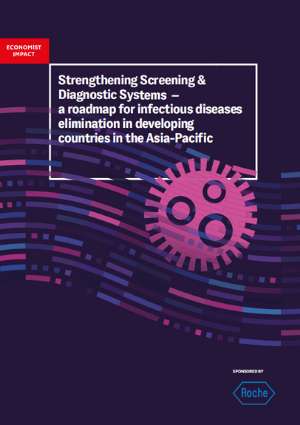Strengthening Screening & Diagnostic Systems - a roadmap for infectious diseases elimination in developing countries in the Asia-Pacific, is an Economist Impact report, supported by Roche Diagnostics Asia Pacific Pte, Ltd.
The report focuses on four infectious diseases which are common in many countries in the Asia-Pacific. These are: hepatitis B and C, the human immunodeficiency virus (HIV), the human papillomavirus (HPV), and tuberculosis (TB). We examine the critical role of screening and diagnostics, both in patient care and in addressing the public health threat that these diseases present, with a focus on India, Indonesia, Pakistan, and the Philippines.
Screening and diagnosis, often overlooked and undervalued, are paramount to addressing the immense burden that hepatitis B and C, HIV, HPV, and TB present. The four focus countries for this report each face unique issues in infectious disease prevention and control, but their experiences also point to shared challenges and opportunities for improvement.
This study of four major infectious diseases in four Asian countries reveals five common policy takeaways:
Diagnostic infrastructure has a crucial role to play in strengthening health systems, achieving UHC and meeting the SDG targets.
The importance of diagnostics has long been under-recognised, and access to diagnostics is chronically underfunded. A re-examination of country achievements against the internationally agreed elimination targets should be a strong incentive to address this. Doing so, in turn, feeds back into the goal of UHC, which can be accelerated by disease prevention through better screening, diagnostics, and monitoring. Investment in screening and diagnostics can also bring efficiency gains for the healthcare system, and as such, a long-term commitment to building comprehensive laboratory networks should be part of national health strategic plans. Hybrid laboratory testing models, with both centralised and decentralised testing as appropriate to the setting, may help to optimise these efficiency gains.
Governments and donors alike should rebalance and reorient health care financing to better support screening and diagnosis of these significant infectious disease threats.
Social health insurance schemes have proven themselves an effective way to finance basic healthcare in many middle-income countries, including in Indonesia and the Philippines. This modality enables governments to design a system that pools population-wide risk, and shares the funding burden with communities, individuals and the private sector through contributions, while building in mechanisms to protect the vulnerable. It also supports stronger data collection, and is a useful policy lever to reach specific health care goals, such as the elimination of a targeted disease. For infectious disease elimination, countries need to imagine a future where domestic sources of funding can support their needs. They may be able to rely on donor funding for particular programmes in the short to medium term, but donor dependency leaves them at the mercy of changing donor priorities, which are increasingly tilting towards low-income and fragile countries. In addition, all four countries have a vigorous private sector in health care and this sector could be more actively engaged. Public-private collaboration, when done well, such as through an interface agency, can make population health gains that cannot be achieved with public sector funding alone.
The covid-19 response increased diagnostics infrastructure: health systems are presented with an unprecedented opportunity to leverage it.
The extent of access to diagnostic and testing technology in the wake of the covid-19 pandemic response in all four countries is unparalleled. Rapid, accurate testing technology is more accessible and more affordable than ever. As demand for covid-19 testing recedes, the same technology can be used to accelerate and scale effective screening, diagnostics and management for hepatitis B and C, HIV, HPV, and TB. This process may benefit from approaches to optimise the use of diagnostic technology, and can learn from other settings, such as the African Society for Laboratory Medicine’s Diagnostics Network Optimisation approach.
Hepatitis B and C and HPV are overlooked both in donor funding strategies and in government policy.
Donor strategies fail to account for the disease burden of hepatitis and cervical cancer. With the growing body of evidence on the costeffectiveness of screening for hepatitis B and C, and for HPV, these diseases should be brought into the fold together with HIV, TB, and malaria for concerted funding efforts, by both governments and donors. The latter could catalyse the former by taking the first step towards national roll-outs of screening programmes for these diseases. All four focus countries in this report, as WHO Member States, signed up to the WHO elimination targets for hepatitis, but actions so far are falling short of these targets. Similarly, despite the fact that WHO recommends DNA-based HPV testing as a first-choice screening method for cervical cancer prevention, this is not included in any of the four countries’ national clinical guidelines. Making the transition from VIA to DNA-based HPV screening offers both health and economic benefits for populations and their health systems.
Entrenched infectious disease burdens are interwoven with broader social and political factors that cannot be solved by the health system alone, and this demands much more active multi-stakeholder collaboration.
The health system alone cannot solve longstanding burdens of disease, which are interwoven with broader social and political factors. They can only be addressed through collaboration across different areas of government responsibility, and between governments, the community, the private sector – and in the case of disease-specific programmes – the patients themselves. More active engagement with the private sector will also stimulate innovation in screening tools, in particular low-cost, high-volume testing technologies that are needed to get screening to the local clinic level, including in rural and remote areas. Engagement with communities and patient groups is also a crucial part of investing in infectious disease prevention education and awareness.






